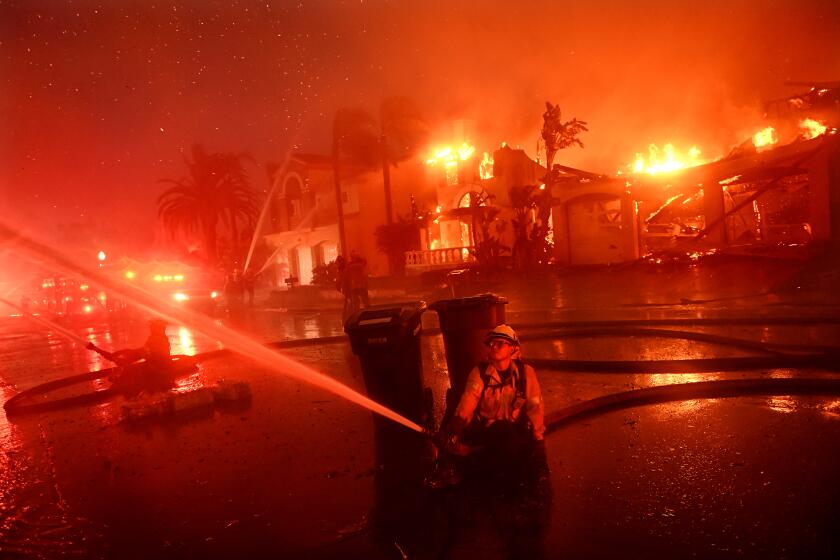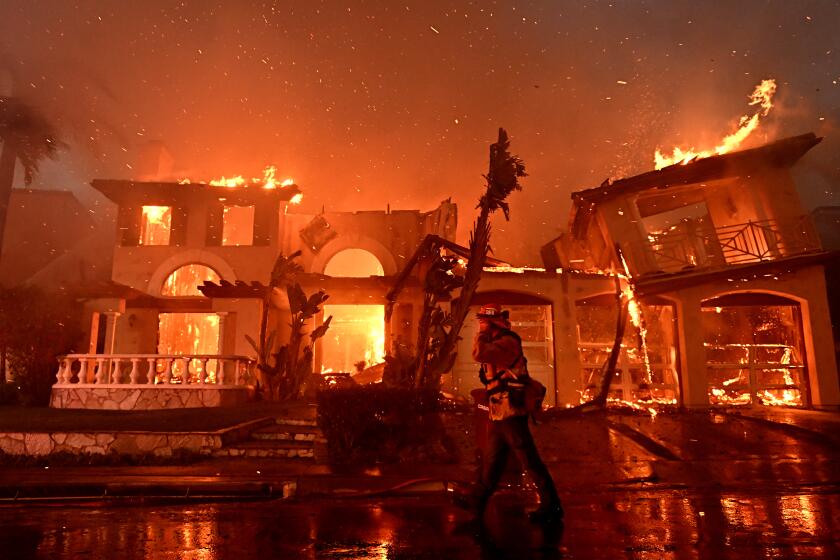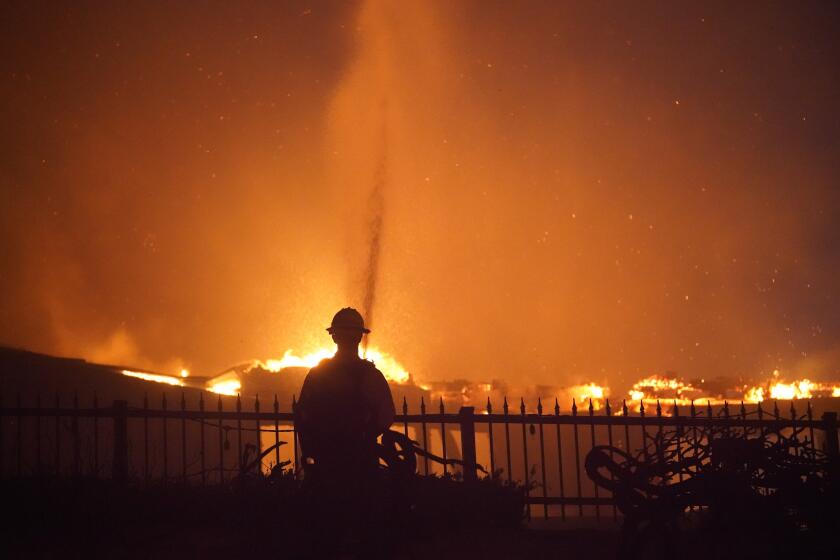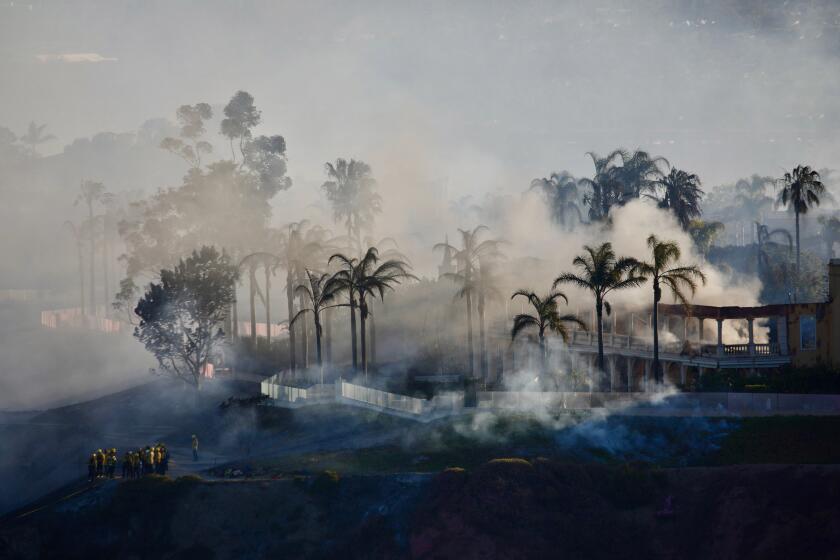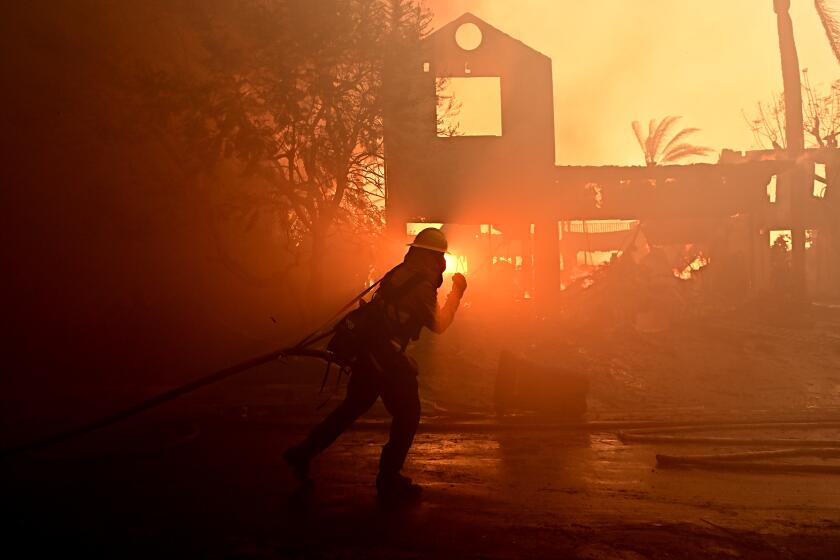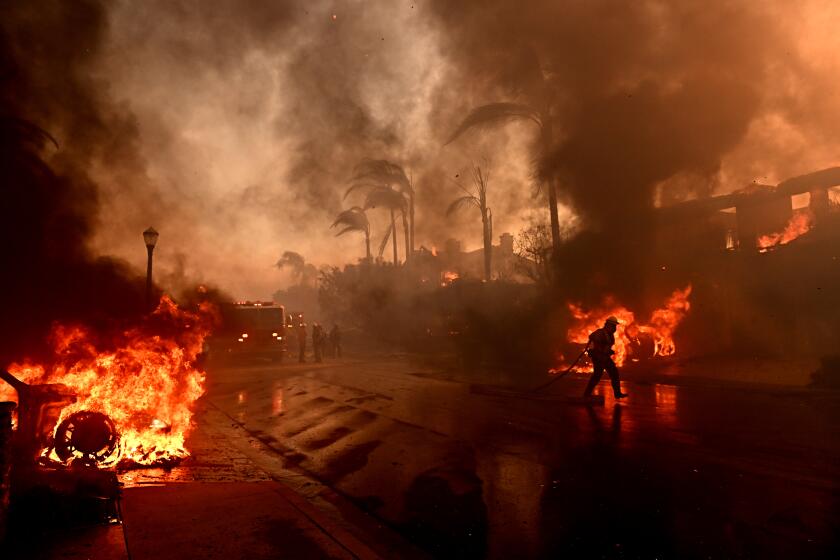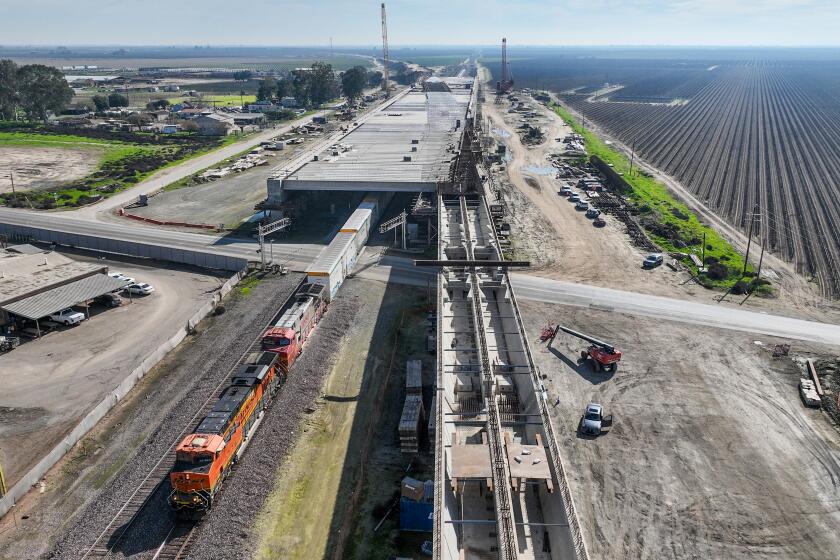Edison flags ‘circuit activity’ at time of fire that destroyed 20 homes, damaged 11 in Laguna Niguel
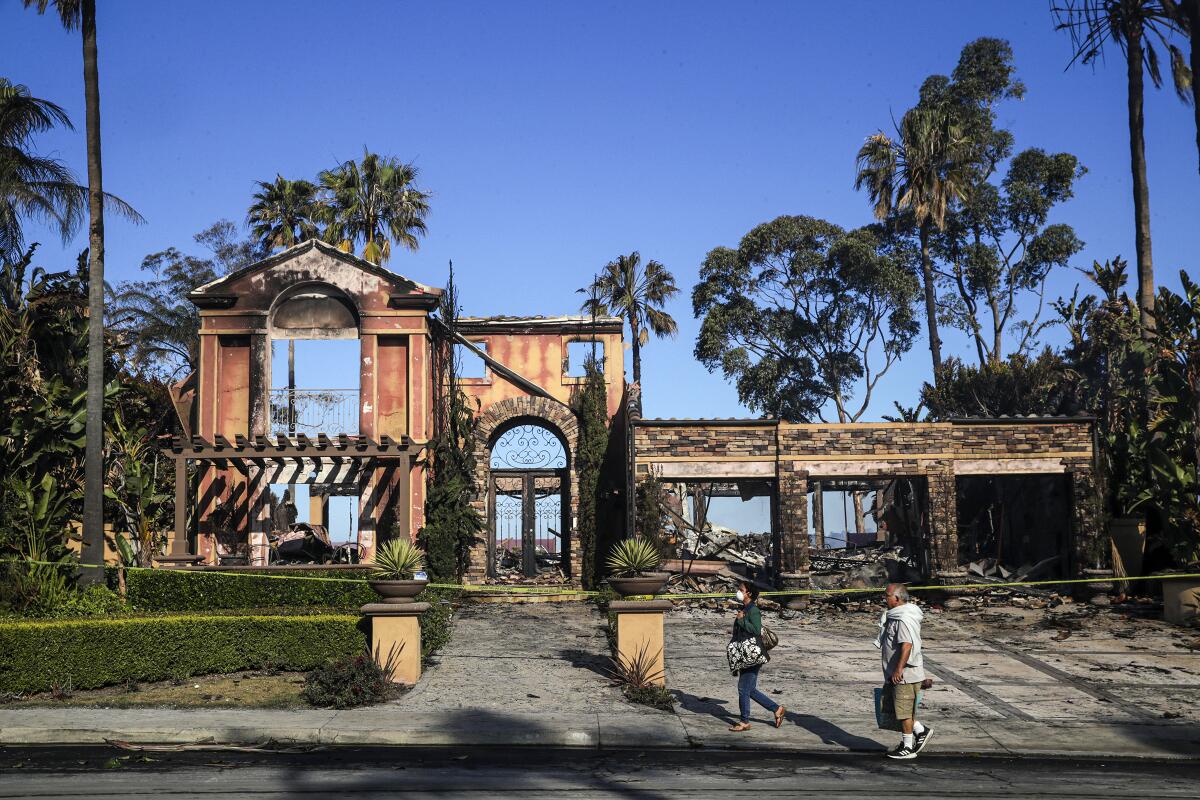
- Share via
Lynn Morey stood in disbelief outside the home she and her husband had shared for nearly a decade.
The once-luxurious rental, with five bedrooms and sweeping views of the Saddleback Mountains, had been completely engulfed by flames. The frame still stood, but the charred rubble inside signaled everything had been lost.
“Well, almost everything,” Morey said, holding up a silver frame containing a lone photograph. It was a snapshot of a happier time, when she and her now-husband, Keith, stood on a hillside overlooking the ocean in 2017 to exchange their vows.
“This brought some sunshine to my heart today,” she said, tightly clutching the photograph as she took in the devastation.
Morey’s was one of at least 20 homes the Coastal fire consumed as it tore through this upscale section of Laguna Niguel. The blaze, first reported as a 50-by-50-foot spot near a water treatment plant Wednesday afternoon, was whipped into a destructive force by a combination of cool coastal winds and a ready diet of normally hardy vegetation left bone-dry by California’s punishing years-long drought.
Smoke still hung in the air, and ash rained down Thursday as firefighters sprayed down homes in the gated Coronado Pointe community. Fire engines lined the streets as residents returned, many wondering whether their homes had been spared and questioning how the blaze had overtaken the neighborhood so quickly.
While residents try to pick up the pieces, officials are working to piece together the fire’s possible origins.
The probe is still in its early stages, and nothing is yet known for certain. However, Southern California Edison issued an initial report to state regulators saying that “our information reflects circuit activity occurring close in time to the reported time of the fire.”
No other details were provided.
Driven by winds from the ocean, the Coastal fire roared into an Orange County subdivision, destroying 20-plus homes, authorities said.
“Our thoughts are with the community members whose homes have been damaged and those who were evacuated because of the Coastal fire, and we’re coordinating with fire agencies as needed to ensure firefighter safety,” said David Song, a spokesman for the utility.
Song said Edison’s report — which is required for certain types of events — is intended to put the California Public Utilities Commission “on notice of an incident, so that it can conduct its own investigation.”
“Our top priority is the safety of customers, employees and communities, which is why we continue to enhance our wildfire mitigation efforts through grid hardening, situational awareness and enhanced operational practices,” he added.
Some of California’s most destructive blazes have been caused by power lines damaged by winds, including the Paradise fire and the massive 2017 wine country firestorm. Edison faced more than half a billion dollars in fines from the California Public Utilities Commission last year related to several big fires, including the Thomas and the Woolsey.
As of Thursday evening, the fire was 200 acres with 15% containment, said Shane Sherwood, incident commander with the Orange County Fire Authority.
The fire destroyed 20 structures and damaged 11, Sherwood said, adding that all of the structures destroyed were homes. An assessment team is still combing through the burn area to ascertain the full extent of the damage.
“We continue to work with the city of Laguna Niguel to handle and address any of the impact [on] residents in that community,” he said. “Talking about our upcoming weather, we still had afternoon winds and we expect the weather to get hotter and drier over the next few days.”
The change in weather will pose additional challenges to firefighters as crews work to contain the blaze, Sherwood said. There were 550 firefighters assigned to the incident early Thursday night.
Two firefighters were injured while battling the blaze; both were evaluated at a hospital and released, Sherwood said.
Fire crews worked Thursday to reinforce containment lines on the blaze, which was still smoldering.
During a Thursday evening news conference, Sherwood said crews had been mopping up hotspots and using hand tools and water to cool lingering embers, particularly in areas of heavy brush.
“I know it’s been a long night for the people of Laguna Niguel,” said Orange County Supervisor Lisa Bartlett. “My thoughts and prayers go out to all the residents who have been affected by this terrible fire.”
Images of a fire fueled by intense ocean winds that barreled into a gated community overlooking the Pacific Ocean in Laguna Niguel.
The fire advanced on Coronado Pointe with a vengeance, forcing residents to flee with little more than what they could carry.
Morey had been out running errands Wednesday afternoon and couldn’t get back before the fire arrived. Her wedding photo, along with an Apple computer, were the only items firefighters had time to salvage before flames consumed the home.
Sassan Darian, 38, didn’t have time to grab anything except his family. His father, Ali, wanted to stay behind with a garden hose to fight, but Darian pulled him out as the flames grew closer.
His daughter — 7-year-old Artemiz — was terrified by the ordeal, he said, and sobbed as they left the house.
The wind-driven brush fire began about 3 p.m. Wednesday in a canyon near Laguna Beach and raced uphill, reaching a subdivision at the top of the crest.
“I think we stayed about five minutes too long for safety reasons,” he said. “When we got outside, firetrucks had already arrived and the heat was just overwhelming.”
Darian’s family has lived on the street since he was 10. They loved the location — just a few miles from the beach — and the tightknit feel of the community.
“It’s just surreal,” he said, holding his cat, Cyrus, as he looked at his childhood home. “There’s just so many emotions.”
But he’s also grateful.
“All of our photos and videos are backed up on the cloud,” he said. “We all got out safely, and that’s what matters.”
A smoke advisory remains in effect for a swath of Orange County as crews work on the Coastal fire, which has destroyed at least 20 homes in Laguna Niguel.
Sandy Vogel stood outside what remained of her home of three decades holding a wooden birdhouse. The 20-year-old miniature aviary, which her son had just plucked off a tree, was one of few items she has left from her home.
Vogel fled Wednesday as flames threatened to overtake her neighborhood — grabbing some jewelry, documents and the five family photos that once lined their mantel. She regrets not taking her wedding album, but there just wasn’t time, she said. Authorities were yelling for them to evacuate. Embers rained down and burned her sweater as she left.
“We didn’t think our house was going to burn, but the winds were so strong yesterday that once the fire came up the hill there was no stopping it,” Vogel said. “We didn’t know the house had burned until we saw it on the news.”
Vogel and her husband purchased the home just after it was built in the early 1990s, drawn to the large lot and the ocean view. As she surveyed the damage, she recalled all the memories they’d shared within its walls — baby showers, engagement parties and idyllic weekends spent with their two children in the backyard pool.
“It’s 30 years worth of memories,” she said, her voice catching. “We’ll rebuild and we’ll see if we want to stay here. Maybe it’ll be too hard.”
As firefighters battled to save homes in the Coronado Pointe neighborhood, fleeing residents wondered whether theirs had survived.
The destruction underscores the year-round danger of fires in Southern California, even in cool conditions.
“It’s sad to say that we’re getting kind of used to this,” Orange County Fire Authority Chief Brian Fennessy said Wednesday. “The winds we experienced today are normal winds. … We’re seeing spread in ways we haven’t before. Fire is spreading very quickly into this very dry vegetation and taking off.”
Unlike many wildfires in the region, the Coastal fire was fanned not by Santa Ana winds from the desert but by strong gusts coming from the Pacific Ocean, which reached 30 mph in parts of Orange County on Wednesday.
The brush in the area is drought-resistant but has wilted during a years-long dry spell. Fennessy said the fire broke out on what he would call a “normal” day. It wasn’t a Santa Ana wind event, and the humidity was high, around 70%.
“What we’re seeing that we haven’t seen in years past is these fires are starting and the vegetation is so dry that with any wind behind it —even a normal wind for that area — it’s going to spread faster than we’re used to and faster than we can get our units at the scene,” he said.
Fennessy said he was in backyards during the blaze’s chaotic first hours and did not see anything that would cause him to believe there was a real challenge with the defensible space around homes.
“Once the fire hit the base of the hill below the homes it was like an arrow that just shot to the top,” he said.
Residents describe what they saw and experienced as fire consumed a Laguna Niguel community.
Sherwood also spoke Thursday evening of the effects of climate change and drought.
“In the firefighting world, some of the things that we look at are what impacts or what drives a fire … the fields, the topography and the weather,” he said. “And when all three of those come into alignment like we had yesterday, we have the devastation that we see today.”
Brush and other plants in the area are extremely dry, Sherwood said. The homes also sit directly above canyons that channel the winds, which were extremely strong Wednesday.
“And when all three of those components come together, there’s very little that the firefighting efforts can do,” he said. “The biggest thing that we want to do is get the folks out of the way. ... It was really those fuels being as dry as they were, the strong winds and alignment on the topography [that] created the devastation.”
“We must replace dry, hazardous vegetation, especially dead limbs and trees prone to spread fire, with drought tolerant plants and trees that retain moisture even in a drought, to reduce the chance of wildfire causing damage, county Supervisor Katrina Foley said in a statement.The cost of investing in preventive measures pales in comparison to the cost to respond to the fire, the loss of property and, worse, life.”
The wind has been one factor in the spread, and the size of the homes has also made containing the blaze difficult, officials said.
Fennessy, the Fire Authority chief, watched Wednesday afternoon as firefighters saved a home even as the homes on both sides of it burned. The firefighters were spraying water to cool between the homes and keep the structure from being taken down by the flames.
Fennessy said the crews weren’t going to be able to save the homes that were already burning, but they could save the house in the middle.
“When you see photos of a big fire sometimes you’ll go back and wonder why did that one or two survive,” he said. “More times than not it was because firefighters were there protecting what we would call the exposures. What you’re seeing is a direct result of their efforts.”
This is Orange County’s fourth fire of significant size this year. The Emerald fire broke out in Laguna Beach in February. And in March, the Jim fire broke out in the Cleveland National Forest and another ignited near Ortega Highway near San Juan Capistrano.
“We don’t have a fire season,” said TJ McGovern, assistant chief of operations for the Orange County Fire Authority. “It’s year-round now, and these last four fires that we’ve had just proved it to all of us.”
Times staff writer Alejandra Reyes-Velarde contributed to this report.
More to Read
Sign up for Essential California
The most important California stories and recommendations in your inbox every morning.
You may occasionally receive promotional content from the Los Angeles Times.
